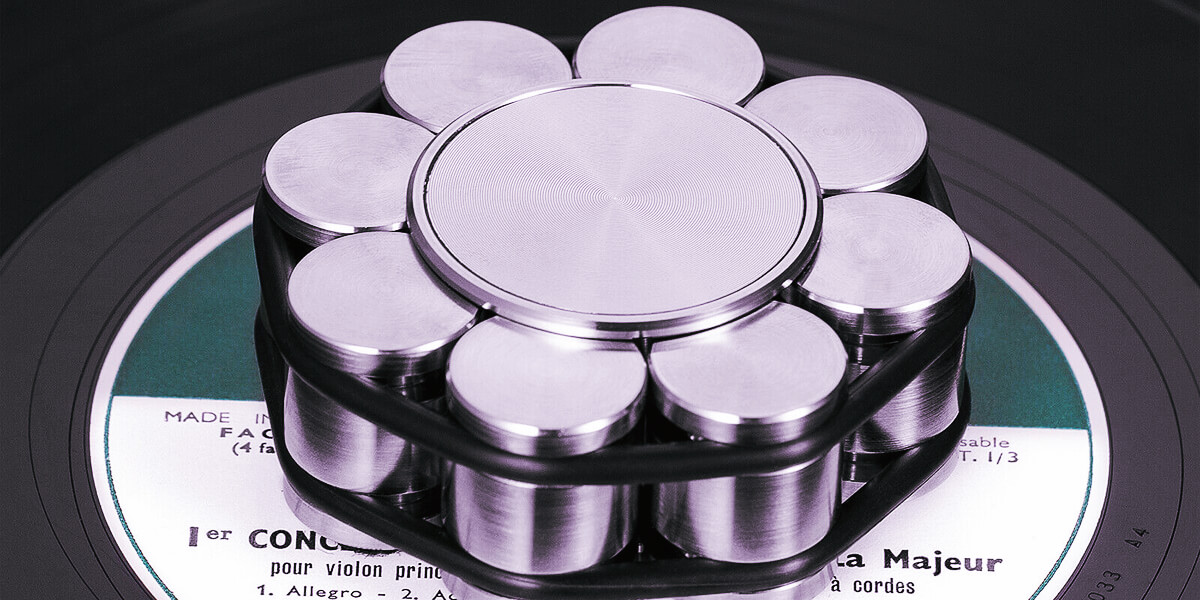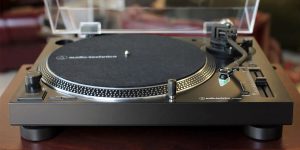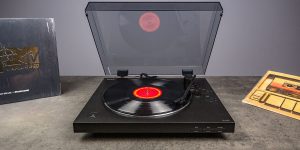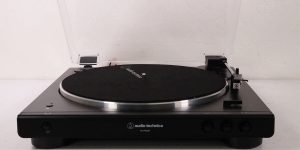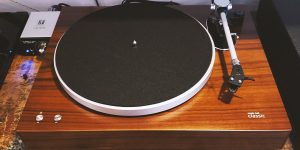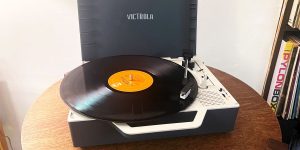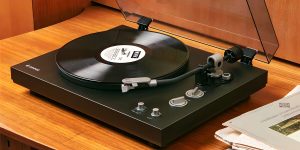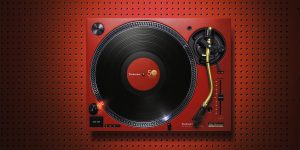I’ve often wondered about the various accessories that promise to enhance my listening experience. Among other items, vinyl record weight stabilizers (also known as turntable weights) and clamps have captured my attention. So, do these little gadgets actually improve sound quality and stability? That’s the question I set out to answer, and I believe the insights I’ve gathered will pique your interest too.
I’ll explore how these accessories impact your records and turntable performance in this article. So, if you’re a fellow audiophile looking to get the most out of your vinyl collection or simply curious about turntable accessories, read on.
Do you really need them?

Improved sound quality
One of the primary reasons audiophiles consider adding a turntable weight or clamp to their setup is the potential improvement in sound quality. These devices work by applying even pressure on the record. This results in better contact between the vinyl and the platter. Consequently, this leads to a reduction in unwanted vibrations and resonance that may negatively affect sound reproduction. That is why you might experience enhanced audio clarity, tighter bass response, and reduced distortion.
Stabilized records
Another advantage of using these accessories is the increased stability they provide for your records. By securing the record firmly to the platter, weights and clamps can prevent records from slipping or wobbling during playback, particularly those that may be slightly warped or uneven. This stability not only helps maintain consistent speed but also ensures the stylus remains in optimal contact with the record groove. Hence, minimizing potential tracking errors.
Enhanced bass response
In addition to improving overall sound quality, turntable weights, and clamps can specifically enhance bass response. By reducing vibrations and resonance, these devices allow the stylus to pick up the low-frequency information more accurately, leading to a richer and more controlled bass output. This can be particularly appealing to those who enjoy listening to music with prominent bass lines or genres that heavily rely on low frequencies.
How do turntable weights work?

A turntable weight, also known as a record player weight or stabilizer, is an accessory designed to apply pressure on a vinyl record during playback. By increasing the contact between the record and the platter, turntable weights aim to reduce vibrations, stabilize records, and ultimately enhance sound quality.
Types of turntable weights
A wide range of turntable weights are available, varying in size, shape, materials, and designs. Some common types include:
- Standard weights are typically made of metal and have a straightforward, cylindrical design.
- Clamp weights function as a combination of weight and a clamp, providing additional pressure to secure the record in place.
- Multi-purpose weights may offer additional features, such as built-in bubble levels or vibration-dampening materials.
Your choice of turntable weight depends primarily on the model of your device and the specific needs of your turntable.
How turntable weights work to improve sound quality
Turntable weights improve sound quality by reducing vibrations and resonance during playback. When a weight is placed on a record, it increases the contact between the vinyl and the platter, ensuring that vibrations are more effectively transferred to the platter and absorbed. This leads to reduced distortion, improved audio clarity, and enhanced bass response.
Pros and cons of using a turntable weight
You’ll love using weights for so many reasons, which I’ll cover in a minute. But I also want you to consider potential drawbacks that may affect your experience.
On the positive side, I’ve found that turntable weights genuinely enhance the sound quality of my vinyl records. The added weight helps reduce vibrations, resulting in tighter bass response and clearer audio reproduction. I’ve also noticed a significant improvement in the stability of my records, especially for those that are slightly warped or uneven. This not only helps maintain a consistent speed during playback but also ensures my stylus remains in optimal contact with the record groove, leading to a more enjoyable listening experience.
However, there have been some drawbacks to using turntable weights as well. For instance, I found that the sound quality and stability improvements were not as noticeable when using a high-end turntable with a well-damped platter. This led me to question the necessity of a turntable weight for certain turntable setups. Additionally, I’ve come across compatibility issues with some turntable designs, which can be frustrating, as not all turntables can handle the added weight without causing strain on the motor or affecting the overall performance.
How do turntable clamps work?

A turntable clamp is an accessory designed to secure a vinyl record to the platter during playback. By applying pressure and holding the record in place, turntable clamps aim to reduce vibrations, stabilize records, and ultimately enhance sound quality.
Types of turntable clamps
The market offers an assortment of turntable clamps, each with unique designs, materials, and functions. To help you better understand the options, let’s take a look at some prevalent types:
- Screw-down clamps are fastened onto the spindle to ensure a secure grip on your record, keeping it firmly in place.
- Spring-loaded clamps employ a spring mechanism to firmly hold the record, providing stability during playback.
- Edge-grip clamps are designed to cover and apply pressure to the record’s edges to maintain consistent contact across the entire surface.
- Turntable outer ring clamps encircle the perimeter of the record, providing even pressure distribution and minimizing edge-related issues.
Which type will work better for you? There is no one-fits-all answer. But you definitely should be guided by your personal preferences and the specific requirements of your turntable setup.
Comparing turntable weights and clamps
Turntable weights and clamps are both accessories designed to enhance your vinyl listening experience. They both achieve this by applying pressure to the record, ensuring better contact between the vinyl and the platter. This pressure reduces vibrations, enhances audio clarity, and leads to an overall more enjoyable listening experience.
While turntable weights and clamps share the common goal of improving your turntable’s performance, they differ in their design, application, and the way they exert pressure on the record. To illustrate these differences, let’s take a look at a comparative chart showing the difference between the record clamp and record weight:
| Aspect | Turntable weights | Turntable clamps |
|---|---|---|
| Design | Cylindrical weights placed on top of the record | Clamps secure the record by attaching it to the spindle or the edges |
| Application | Applies pressure vertically on the record | Applies pressure horizontally or around the edges |
| Vibration reduction | Reduces vibrations by increasing mass | Reduces vibrations by securing the record in place |
| Compatibility | May not be suitable for some turntable designs or motor types due to added weight | Generally more compatible, but some designs may not fit all turntables |
| Ease of use | Simple to place and remove | May require additional steps for secure attachment |
There are certain situations when a turntable weight or a clamp might be more suitable. So let’s compare record clamp vs weight and see in what scenarios each might be more advantageous.
When it’s better to use a turntable weight
I’ve discovered certain situations where using a turntable weight has made a notable difference in my listening experience.
Firstly, I’ve noticed a significant improvement in bass response and overall warmth in my records when using a turntable weight. So, if you, like me, appreciate a more natural, full-bodied sound in your music, a turntable weight can be a game-changer. The improved contact between the record and the platter contributes to a more authentic and immersive listening experience.
As someone who has used lightweight turntables and tonearms, I’ve found that a turntable weight can provide much-needed stability. So, if you’ve ever dealt with records that tend to skip or jump due to vibrations, a turntable weight can help alleviate this issue by dampening those distortions and providing a more stable environment for your vinyl to play.
For those of you with a low compliance cartridge, using a turntable weight can help by adding mass for proper tracking. This ensures the stylus remains in the record groove, providing accurate and reliable playback.
When it’s better to use a turntable clamp
Choosing a turntable clamp has been beneficial for me in multiple scenarios. For example, I’ve found that a turntable clamp does a great job of reducing background noise and vibrations in my records.
Similarly, a turntable clamp has helped me minimize unwanted sounds like hiss and surface noise and enjoy a cleaner audio experience. If your turntable has a thin platter that needs added mass for better stability, a clamp will come in handy, providing the necessary support.
I’ve also discovered that if you have a cartridge with high compliance that requires a tighter grip on the record surface, a turntable clamp can effectively address this issue. Moreover, if you prefer a more focused, detailed sound in your music, be sure that a clamp will contribute to achieving that desired audio quality.

